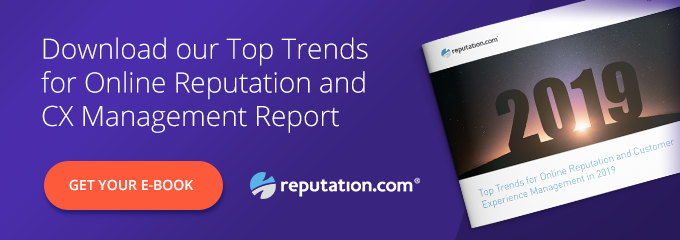The New Customer Truth: Advocacy Is Leased, and Your Rent Is Due at Every Consumer Touchpoint
Reputation Staff Writer

This post was originally published on LinkedIn. Click here to follow Reputation.com on LinkedIn.
Have you tried repeatedly to measure customer sentiment about your brand, only to come up short and with little actionable data? Maybe you implemented CSAT, NPS or other loyalty assessments, got some good feedback, but struggled to make effective changes that move the needle. If this rings true to you, you’re like many businesses whose customer experience programs and initiatives miss their mark.

In my last post, I introduced a detailed map of the new customer journey and the idea that constant awareness and consumer feedback have leveled the playing field between marketers and buyers. The customer “moment of truth” has evolved into a continual and ever-flowing state of “mini-truths” that are defined at every interaction a consumer has with your brand.
In other words, advocacy is no longer an end state resulting from a carefully planned set of interactions. Advocacy is a moving target – influenced at every customer touchpoint – composed of the sum total of many small experiences over time.
Here’s an example: I receive an email from a company selling a service I need. The email is well-written and executed, and provides an appropriate and appealing call to action, maybe to download an ebook. I read the ebook, and I’m convinced I need the service. Those are two great interactions, and my advocacy for this company is building.
But when the sales rep calls me to follow up, he’s rude and can’t provide me with the information I need to help me make my purchase decision. Now, my advocacy is waning. I go online, and see 12 recent reviews of the service — all stellar. I dismiss my bad interaction with the sales rep and purchase the service.
Next, I have some issues with the product after using it for a week — and I get angry. Why did I spend this money? I would never recommend it to anyone! So I do what many people do these days – I leave a nasty review on Google. But then, the customer service team reaches out proactively with a solution, apologizes for the inconvenience and prorates my monthly license fee. I’m happy again, and I go onto Google and delete my negative review.
My truth about this service and the business providing it changed five times in a very short time period. And who knows? It may change again. Customer experience is not static — it is constantly in flux. Failing to track and manage it on an ongoing basis is a recipe for losing business.
To build long-term customer loyalty and advocacy, not only do you have to be present at every touchpoint; you have to be able to take action at every moment of customer truth.
Why Traditional CX Programs Don’t Cut It Anymore
Traditional CX programs were based on the premise that the relationship between the customer journey and customer advocacy was linear: Build this journey map, follow this process, listen to customers, gather the data and take action, and over time, you will turn your customers into advocates. Remember the old Procter & Gamble focus groups? Ad agencies would test consumer goods by bringing people into a room and asking them questions. It took many years for agencies to figure out there was a big difference between what people said they would do in a focus group setting, and what they actually did in the real world.
Then came NPS surveys, which aimed to predict how likely customers are to promote your brand. NPS surveys held great appeal because they claimed to deliver an empirical answer to what is really a subjective question: “On a scale of zero to ten, how likely are you to recommend this business, product or service to a friend or colleague?” Most organizations quickly realized this didn’t deliver the level of detail they needed. But many fell into the trap of assuming MORE structured questions would help fill in the blanks. I’ve personally participated in many discussions around soliciting this type of structured feedback. Here’s how the conversation typically goes:
“Is our survey one question or 30? Should it take five minutes or 10? Do we send our survey via email, in-product or both? What about telephone interviews and our community forums? Are we sending transactional surveys or relationship surveys or both? Are we sure our lists are accurate? What about list fatigue? How will the score be calculated? We survey our customers too much. How do we know our survey is getting to the right people? Do we use a 5-, 10- or 11-point scale? Are we looking at a month-over-month score or trailing 12-month score? Why isn’t this getting better faster? How is this going to impact my bonus?”
_1900x.jpg)
Social media and review sites have amplified traditional word-of-mouth.
I’ve lived through enough well-intentioned executive sessions to know that building the program based on traditional structured data leaves way too many variables open for interpretation — and therefore too many gaps. This is one of the root causes of why your CX program isn’t working.
In fact, the whole premise of basing CX programs on structured data is flawed for three specific reasons:
- The customer journey has evolved and so has the opportunity to impact the desired “advocate” outcome. Advocacy is now achieved through being present and empowered to act at every customer truth moment. I discussed this topic in detail in the first post of this series.
- The number of meaningful customer listening posts has increased dramatically with the evolution of the web, social media and smartphones. The data collection methods of old are structured and don’t account for the astronomical amount of data “in the wild.”
- Even if they have the capability to get all the data they need, businesses often lack the resources or the capability to continually mine that data and form it into actionable models for change. The new world requires actionable data at every step of the journey and the ability to pivot — in real-time.
Today, customer truth data doesn’t exist on NPS surveys or in focus group notes — it’s “in the wild” — and it’s available for everyone to see and leverage. Data in the wild is all the unprompted feedback a customer provides. It’s the 21st-century version of word-of-mouth but, thanks to social media and review sites, it has a lot more power and reach. It’s a survey response, a social post, a blog mention, an online review, a photo on Snapchat or a Facebook conversation. It’s out there — permanently — and it has the power to shape how people view your brand at any given point in time.
Think about how your own buying behavior has changed. In the last couple of years, you probably haven’t made many purchases without first reading reviews. Today, 95% of customers will read reviews before making a selection. And the purchase likelihood for a product with five reviews is 270% greater than for a product with no reviews.
The reality is, spending exorbitant amounts of time, effort and energy on collecting and analyzing structured data from NPS and CSAT programs is pretty much useless. The real treasure trove of data is sitting right in front of you — and it’s not only findable; it’s actionable.
What Does Actionable Data Look Like?
It looks like whatever the person who agrees to take action on it says it needs to look like. Just because different departments have different responsibilities doesn’t mean that they don’t share some common goals. Marketers are concerned with brand, reputation, customer loyalty, revenue and profit. Operations/service people are concerned with quality, efficiency, scale, customer loyalty, revenue and profit. If you are going to enable cross-departmental relationships that respond to and answer customer truths, you’re going to have to make it simple for the teams to communicate and take action on what your customers are saying.

CX management platforms are helping companies wrangle customer feedback data.
How Do You Harness Data in the Wild?
The problem is, most businesses are not set up to leverage unstructured data effectively. Significant investment in data collection, assembly and delivery is a luxury that many companies don’t have. Adding the responsibility of “business intelligence” to the job description of someone already on staff is not only frustrating to the unlucky employee; he or she may lack the necessary formal training and bandwidth to effectively compile and analyze the data. The result? Your customers’ truths are never known or addressed.
If businesses don’t find ways to overcome this hurdle, they will (over the long-term) miss the opportunity to pivot and will have to rely on their next new “product” to keep them afloat. This approach is not sustainable — the business graveyard is littered with companies who didn’t meet the changing needs of their customers. To compete effectively in light of the new nonlinear customer journey, businesses must strike the balance between product innovation, a commitment to service that meets customer needs, and an actionable approach to feedback.
Comprehensive reputation and CX management platforms such as Reputation.com are helping multi-location businesses harness unstructured data and analyze it together with more traditional forms of customer feedback data for a 360-degree view of the customer truth. The ability to track, collect, analyze and report on data on an ongoing basis is helping companies stay on top of — and take action on — changing customer truths.
New Truth, New Approach
The social media revolution has changed the way the world does business. As a result, businesses must change their approach to the collection, gathering and action responses of their customer feedback and sentiment. You want to know what people really think? Collect and analyze all of the data your customers are sharing — both structured and unstructured. You need to meet your customer truths head-on, show customers you’re listening and take action. That’s how you get on the path to advocacy.
In my next post, I will explore how the value gap is disrupting NPS and how departments must collaborate to win customer advocacy. Stay tuned!

